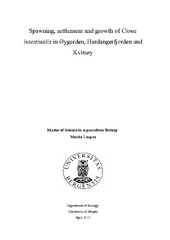Spawning, settlement and growth of Ciona intestinalis in Øygarden, Hardangerfjorden and Kvitsøy
Master thesis
Permanent lenke
http://hdl.handle.net/1956/10332Utgivelsesdato
2015-04-24Metadata
Vis full innførselSamlinger
Sammendrag
Due to the increasing aquaculture industry, new resources for feed should be assessed. A high protein content in Ciona intestinalis have increased the interest to farm C. intestinalis, and use as a feed resource. In addition, C. intestinalis has a tunic of cellulose, which can be used in biofuel production. The ascidian C. intestinalis is abundant in temperate regions, and is characterized by rapid growth, early maturation and high reproductive output. To examine the maturation, broodstock animals were collected from 4 different locations, in three different areas; Øygarden, Hardangerfjorden and Kvitsøy. Collection occurred between March and June. Broodstock animals were examined, and dry weight and maturation index was found. Eggs in the gonoduct were collected, and examined using a stereo microscope. The growth and settlement were found using submerged PVC plates at 5 to 25 m depth at 5 locations in three different areas; Øygarden, Hardanger and Kvitsøy. Plates were deployed in March to June, and retrieved in mid to end October. 30 individuals were collected from each depth for the different deployment times from each location in order to investigate differences in dry weight with time of deployment and depth. This study showed that maturation of eggs occurred earlier than expected, and with large variations between locations. The number of eggs varied considerably between individuals. High settlement of C. intestinalis was found in all locations except Kvitsøy. This study showed that depth and time of deployment are important factors to obtain a high biomass. The highest recruitment and dry weight was found at 10 and 15 m depth at all locations, and on plates deployed from March to May.
